IceRyder
Friendly Games
Friendly Game: Throw the lead rope over the horse's back, underneath,
around legs. Put the rope under the tail. Lift a leg with the rope. Toss
the rope from side to side over the head. Play the game with a tennis
racket, whiffle bat, plastic bag, hat, whisk, umbrella, tree branch with
leaves, coat, hose, cat, lariat, carrot stick/string, muck rake, shovel,
kitchen mop, safety vest, squirt gun, paper bag, feed bucket. When you're
good at all
this, try it with a plastic chair. Practice hitting the ground with the
carrot stick/string without affecting your horse. Touch your horse
everywhere including sheath, under tail, inside nostrils, ears, mouth.
Don't forget the "button" that lifts the tail. Use the plastic bag under
the tail. Try standing on a bucket or
sitting on the fence and throwing the rope all around. Walking over
tarps--all different colors, some laid out flat, some crumpled up. Put a
tarp over the horse's body, and then over his head and body. Put yourself
under the tarp and move (is your horse ok with this?). Walk drunkenly
toward your horse, or skip, jump, dance, flail, run. Also try this with
flapping chaps on. Bounce a ball around your horse, kick it under and over
him, bounce it off his side (maybe a beach ball). Play with balloons (maybe
helium). Noise--Try bells, keys,
whistles, horns, manure shovel banging against pipe corrals, spray bottle,
radio, party favors, noisy hoola-hoops, bag of aluminum cans, kids toys,
the crack of a bull whip, cap gun, clippers, hair dryer, vacuum,
etc. Drag a milk container with pebbles in it, or 3-4
tin cans. Expose the horse to traffic sounds, earth movers, flashing
lights, etc. Smells--expose him to many different smells including but not
limited to other animals or the manure of animals that you may meet on the
trail someday,
i.e. llamas, pigs, goats, sheep, etc. (rabbit skins, fox fur, etc.) Body
massage (possibly TTouch), endorphins are released at the base of the ear,
the nose, upper gum line, and by folding the ears and pulling to the tip.
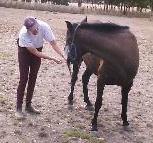
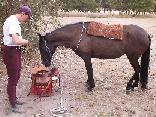
Yvonne is bridging the Parelli Natural Horsemanship tasks with clicker training. Magia is "smelling her tail"--a good way to get lateral flexion and suppleness to the back. Also, Magia is smelling (acknowledging) her saddle.
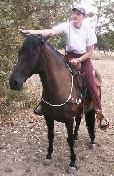

Magia stands patiently without headstall and then gives her head for bridling under saddle. Magia opens her mouth by herself to receive the bit.
Contact Yvonne
For additional and larger photos of Magia and Shaleema, go to Yvonne's Website
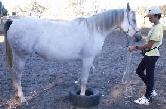
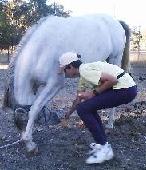
Yana is having Shaleema bring her front feet into the center of the tire and then "standing on her head", as Greg says. Nice preparation for the bow; additionally good stretch for the neck and back muscles.
Under Saddle Friendly: Twirling hoola-hoops, toss bag of crumpled aluminum
cans, play with a tarp, crack a bull-whip, have people hand you things
(coat, slicker, umbrella, etc.). Have someone run at you with scary things.
Ride with streamers.
Don't try everything in one day! Slowly is the best way to go. Use
approach and retreat if the horse shows any sign of nervousness. We're
looking for long-term good relationships. No fear or pressure.
The porcupine game will teach your horse to yield to pressure. Assuming
your horse leads, we can start into the other parts of the game. If your
horse does not lead well, you probably need to work on that first. Be sure
that he will give his head to pressure on the halter and try to lead him
from both
sides so that he gets used to seeing you from both eyes. It will help to
make him more even-sided. Optimally, you want your horse to stay at your
side (or behind whichever you choose) on a loose lead.
OK, keeping in mind that "it's the release that teaches" and the "release is
the reward" you can start on the following:
By putting pressure on the horse's nose, ask your horse to back up. At
first he may not know what you want. He may try to escape your hand by
moving his head up, down, or sideways. The horse is trying to guess what
you want. Stay with him until he slightly shifts his weight back. Instant
release. That is his signal that he guessed correctly. Try again and quit
the pressure as soon as his guess is going in the right direction. Build on
this until you get one step back and you're on your way to a back-up. This
may take only a few minutes or several days depending on the horse. Don't
get frustrated if the horse does not catch on right away. He doesn't know
the rules to the game--or even what game we're playing! You may have to try
this on another human (without words), by pressing into their face. See if
they guess correctly. Between every request, leave some time for the horse
to think (30-60 seconds). You may see him lick and chew. When the horse
guesses correctly, he is rewarded with the instant release of pressure and
also the time that nothing is asked of him. You can additionally reward
with "good boy" and a scratch. Treats are also helpful.
By putting pressure on the poll, ask your horse to lower his head. As soon
as it lowers just a smidgeon, release. You can build on this until he
lowers his head to the ground.
By putting pressure on the horse's chest with your fingers, ask him to back
up. Remember all the things noted in the back-up by nose. Instant release
for a guess that is in the right direction. Think time. Reward. Don't
spend a half an hour working on this. Under 5 minutes is good enough to
start.
Using the same methods, ask your horse to tip his head to the left. Then to
the right.
Ask your horse to lift his foot by putting pressure on the chesnuts (front
legs) and tip of the hock (back legs). At first release the pressure as
soon as the horse shifts his weight off of the requested leg. What we'll be
looking for is that the horse lifts his foot by himself just at the request.
The reason for using the chestnuts and tip of the hocks is to keep your head
out of the "football" (kicking) zone.
Ask your horse to lift his tail by pressing the tail-lifting "button". This
button is located next to the anus (sort of where east and west would be if
the anus was the center of a compass). You might have to feel around until
you hit the right spot. You might consider not standing down wind as this
exercise helps the horse to release gas.
Standing on the side of the horse, tip his head toward you as you bring his
tail to his nose. He needs to "smell" his tail for a few seconds. The
horse may try to disengage his hindquarters, but he will eventually stand
still.
Here's a good one to help your horse learn to yield to pressure: If you are
standing on the left side of the horse, put the rope over his head, to the
off side of his whole body. Step back and put a little pressure on the lead
rope. Your horse may try to turn towards you (which is fighting the
pressure) or try to back up. What we'd like him to do is yield to the
off-side pressure, moving away from you until he "untangles" himself (sort
of twirling out) and ends up facing you. This is a good exercise to teach
the horse to yield to pressure if he ever gets caught up in something.
Hopefully, he'll yield instead of fighting and hurting himself.
Riding Games
We did a lot of interactive games....throwing a tennis ball from one to the
other while we walked in a group...(more like tag..you knew who could
tolerate you trotting up behind and who couldn't yet manage that.).we all
got better at it. Passing the carrot stick...we tried this at the canter at
one clinic..I'm not that good a shot, but it was fun. Strange friendly
games for snorting horses, where everyone rubbed something on the nervous
horse...I spent one ride just whirling the rope about until Prancer ignored
it, then Nathan came by whirling his rope at a canter!. We also did a
zigzagging between horses game, simply walk or trot in a single file, then
the last horse has to serpentine between all the others until it is the
first horse, at which time the new last horse bends it's way to the front
and so on. This is fun for several reasons, if you are serpentining forwards
you have to travel faster and bend around lots of other horses. If you are
in line you have to keep you pace even and allow enough room for the
overtaking horse to get by, of course we didn't try this on narrow trails..
But you could do this lots of other ways too.
We thought of lots of childrens games and did them while riding along. We
took some cattle working ideas one time and pretended to cut out another
horse and work it....mirror image movements by two horses. It was fun,
unfortunately most of the group are now doing other things, but still we
played cowboy polo the other day with three of us, but not on the trail, in
an arena. We used carrot sticks and a large plastic ball. I was amazed,
Prancer just walked all over it, no worries, only problem was i'd focus on
the ball and he would head straight for it...and then I'd be unable to hit
it because we had walked or trotted over it. Great focus, shame about the
rider!
Just thought I'd share a fun time I had today at a Pony Club ground
where bits and pieces of equipment were left out. There were barrells
and some jumps, poles and sandpits and bog holes. After trotting and
cantering around for a while we started point to point riding. At
first it wasn't the best, but we improved and got to where we were
cantering pretty well between points and stopping on cue (ie my focus
improved!) When I was feeling comfortable with this we tried going
over a jump, then focussing on a barrell and riding to it, then going
over the jump and through the sand and then the barrell, then over the
jump and through the bog to the barrell and then on to another barrell
etc. We got better and better at this, each time coming to a great
stop and backup at the barrell or post or whatever was the chosen
stopping point I'd focussed on. Up till today our point to point
riding had been a pretty boring affair really .... not any more,
incorporating jumps and other equipment was much more fun, and Ellie
really cottoned onto the game and was looking forward each time to the
rest so that our stops were quite impressive!
Why does it so often take so long for the imagination to kick in!!??
I thought of another fun thing we do on the trail...an impromptu
trail tournament. Someone will see a log and go over to straddle
it- other riders will assign points...like, "Oh good, 5 points !".
Then the next person may not only straddle it, but side pass
with the log between the horse's legs.." Oh, nice, 10 points !"
Or they might side pass both ways...more points. Now no one
is really keeping score, but its fun.
Other good ones - look for a low limb and a log so you can do a
double squeeze game. Going through a puddle exactly in the middle
when there is lots of room to go around is worth points. Backing
through two trees that are close together. Just look for things
to play with. One time we were all involved doing little obstacles
over logs and through brush and under limbs and one of the riders
just went around all of it and waited for us. She got "points" for
taking the easy way !
My neighbor and I, both PNH students, have hit upon a great way to go
trail riding. We call it "Parallel Parelli"...We take two horses, two trailers
and spot one at the bottom of a circular trail. Then we haul ourselves
and horses up to the top. We ride off in separate directions, and have
a great time riding alone, practicing our transitions, using leg and seat
for manoevers ,practicing tasks,etc. We are actually parallel to each other,
so when we arrive at the trailer the first person keeps going on the circle
until
we meet up. Then we proceed to the trailer, load up and go get the
trailer at the spot we started. Benefits are we are able to ride alone
and keep our horse's minds on our requests, but know where the other
rider is and make sure we are both safe and sound before heading home
together.
Another variation on this, is to go with just one trailer.
One rider gets dropped off and starts at one end of the trail, and
rides to the trailer, which has been left where rider #2 started out.
First rider drives to beginning of trail and waits for rider #2.
I can't tell you how wonderful these private rides have been for me
and my horses. Of course we pretty much know where the trails will come
out...if we were in new territory I'd want to ride together.
We did a lot of interactive games....throwing a tennis ball from one to the
other while we walked in a group...(more like tag..you knew who could
tolerate you trotting up behind and who couldn't yet manage that.).we all
got better at it. Passing the carrot stick...we tried this at the canter at
one clinic..I'm not that good a shot, but it was fun. Strange friendly
games for snorting horses, where everyone rubbed something on the nervous
horse...I spent one ride just whirling the rope about until my horse ignored
it, then Nathan came by whirling his rope at a canter!. We also did a
zigzagging between horses game, simply walk or trot in a single file, then
the last horse has to serpentine between all the others until it is the
first horse, at which time the new last horse bends it's way to the front
and so on. This is fun for several reasons, if you are serpentining forwards
you have to travel faster and bend around lots of other horses. If you are
in line you have to keep you pace even and allow enough room for the
overtaking horse to get by, of course we didn't try this on narrow trails..
But you could do this lots of other ways too.
We thought of lots of childrens games and did them while riding along. We
took some cattle working ideas one time and pretended to cut out another
horse and work it....mirror image movements by two horses. It was fun,
unfortunately most of the group are now doing other things, but still we
played cowboy polo the other day with three of us, but not on the trail, in
an arena. We used carrot sticks and a large plastic ball. I was amazed,
Prancer just walked all over it, no worries, only problem was i'd focus on
the ball and he would head straight for it...and then I'd be unable to hit
it because we had walked or trotted over it. Great focus shame about the
rider!
More Games
Simon Says: you probably know the horseless version from childhood: A caller
makes a specific command to a group of players. If the command is preceded
by "Simon Says," the riders do as instructed. A rider is eliminated when he
obeys a command that does not include the prefix "Simon Says." There are
many variations: motion commands (walk, trot, halt, etc.), obstacle commands
(barrels, cavaletti, jumps, etc.), pattern commands (using dressage letters)
and any combination - even something as simple as touching parts of the
horse or saddle.
Obstacle Race: Also called "speed trail." Barrels, hay bales, jumps and
poles are arranged in a ring or field to simulate trail obstacles, and
riders see how quickly they can maneuver their horses through the course.
Anything that won't spook or injure the horse can be used, such as wooden
"bridges," a stream made with a running garden hose and sand pits, or make a
course through Mother Nature's obstacles.
Relays: The endless variety of relay races is limited only by your
creativity. Impose a speed limit: walk, trot, canter or gallop. This is a
great way to get your horse to move out at a walk or to work on the extended
trot. Some examples are horse change and ribbon relays, but you can make up
your own.
-In horse change, riders race from one side of the playing field to
the other, dismount, mount their partner's horse and race back across to the
starting area. Fastest team wins.
-Ribbon relays are played in pairs and require good hand-eye
coordination and balance. A ribbon is suspended between two riders, and they
race side-by-side to a designated finish line. At least two teams of two
riders are necessary for this game. A variation would be an obstacle course
with both riders negotiating the obstacles simultaneously.
Egg and Spoon: This tests how smooth your horse is and how in tune you are
with his gaits. Riders rest an egg on a spoon, and the objective is to ride
about the ring or field without dropping the egg. If the egg falls or the
rider touches it, that rider is eliminated. Standard play is sort of like a
western pleasure class: a caller asks a group of riders to walk, trot,
canter, reverse and back. Mounting and dismounting are particularly
difficult, as is the trot. Can also be played on the trail. Anything round
in shape that fits on a spoon can be used - pine cones, nuts, marbles - but
nothing symbolizes "You're out!" like a broken egg on the ground.
Barrel Racing: This popular rodeo event can be recreated in many ways, for
riders of all levels. Variations spice it up: Move the barrels around, add
more or take some away. See who can walk or trot the pattern fastest if
you're hesitant about running flat out. I find it interesting to add a jump
between the first and second barrels or a couple of ground poles along the
way.
Sharks and Minnows: Better known as "tag." The "shark" tries to touch a
"minnow." When he succeeds, the touched rider also becomes a shark and goes
after the minnows. The game ends when all minnows are turned into sharks.
All horses must be sociable animals that won't kick or bite. For safety
reasons, keep it to a walk. Add obstacles to the playing area for spice, and
define the places that can be tagged: rider and horse, just the rider, or
the saddle. "Freeze tag" is a handy exercise to teach horses to stand still
even though others are moving around him.
Flag Race: Several patterns exist, but here's one: Riders race to a
half-filled bucket of sand - usually placed on a barrel, to make it easier
to reach - and pick up a flag, then move on to a second bucket to plant the
flag, then past the finish line. The best time wins and any gait can be
specified.
Red Light/Green Light: Caller stands opposite a line of side-by-side riders.
When caller yells "green light," the riders advance, at an appropriate gait,
until caller commands "red light." After a count of five (or less, depending
on the gait and rider level), the caller turns toward riders. Any horse
still in motion is eliminated. The first rider to ride up even with the
caller wins.
Scavenger Hunt: Riders trek out in pairs to find a list of items previously
hidden throughout the area. Larger areas are obviously better, especially if
there are trees, brush, ponds or creeks to offer more hiding places.
Pages Provided By:

Email: iceryder@cableone.net






